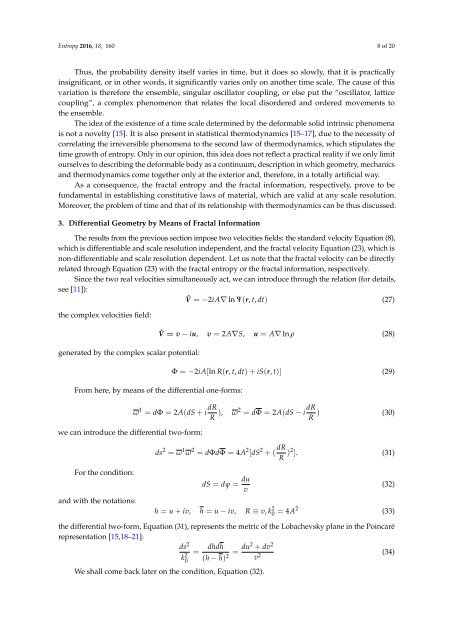entropy-18-00160
You also want an ePaper? Increase the reach of your titles
YUMPU automatically turns print PDFs into web optimized ePapers that Google loves.
Entropy 2016, <strong>18</strong>, 160 8 of 20<br />
Thus, the probability density itself varies in time, but it does so slowly, that it is practically<br />
insignificant, or in other words, it significantly varies only on another time scale. The cause of this<br />
variation is therefore the ensemble, singular oscillator coupling, or else put the “oscillator, lattice<br />
coupling”, a complex phenomenon that relates the local disordered and ordered movements to<br />
the ensemble.<br />
The idea of the existence of a time scale determined by the deformable solid intrinsic phenomena<br />
is not a novelty [15]. It is also present in statistical thermodynamics [15–17], due to the necessity of<br />
correlating the irreversible phenomena to the second law of thermodynamics, which stipulates the<br />
time growth of <strong>entropy</strong>. Only in our opinion, this idea does not reflect a practical reality if we only limit<br />
ourselves to describing the deformable body as a continuum, description in which geometry, mechanics<br />
and thermodynamics come together only at the exterior and, therefore, in a totally artificial way.<br />
As a consequence, the fractal <strong>entropy</strong> and the fractal information, respectively, prove to be<br />
fundamental in establishing constitutive laws of material, which are valid at any scale resolution.<br />
Moreover, the problem of time and that of its relationship with thermodynamics can be thus discussed.<br />
3. Differential Geometry by Means of Fractal Information<br />
The results from the previous section impose two velocities fields: the standard velocity Equation (8),<br />
which is differentiable and scale resolution independent, and the fractal velocity Equation (23), which is<br />
non-differentiable and scale resolution dependent. Let us note that the fractal velocity can be directly<br />
related through Equation (23) with the fractal <strong>entropy</strong> or the fractal information, respectively.<br />
Since the two real velocities simultaneously act, we can introduce through the relation (for details,<br />
see [11]):<br />
ˆV = −2iA∇ ln Ψ(r, t, dt) (27)<br />
the complex velocities field:<br />
generated by the complex scalar potential:<br />
From here, by means of the differential one-forms:<br />
ˆV = v − iu, v = 2A∇S, u = A∇ ln ρ (28)<br />
Φ = −2iA[ln R(r, t, dt) + iS(r, t)] (29)<br />
we can introduce the differential two-form:<br />
ω 1 = dΦ = 2A(dS + i dR R ), ω2 = dΦ = 2A(dS − i dR R ) (30)<br />
ds 2 = ω 1 ω 2 = dΦdΦ = 4A 2 [dS 2 + ( dR R )2 ]. (31)<br />
For the condition:<br />
dS = dϕ = du v<br />
(32)<br />
and with the notations:<br />
h = u + iv, h = u − iv, R ≡ v, k 2 0 = 4A2 (33)<br />
the differential two-form, Equation (31), represents the metric of the Lobachevsky plane in the Poincaré<br />
representation [15,<strong>18</strong>–21]:<br />
ds 2<br />
k 2 0<br />
We shall come back later on the condition, Equation (32).<br />
= dhdh<br />
(h − h) 2 = du2 + dv 2<br />
v 2 (34)



